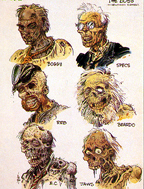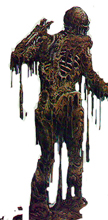PRE-PRODUCTION
By the end of the 1970's, after a series of legalities, all the rights to the Living Dead name were retained by co-writer John Russo, and George Romero (actually his producer Richard Rubinstein) kept the Dead name for Romero's planned trilogy. Russo sold film and Living Dead title rights to the story to Tom Fox of Fox Films in fall 1980, who anticipated a similar success to Romero’s independent smash Dawn of the Dead, backing it with his investor pals at Hemdale.
Tobe Hooper, of Texas Chainsaw Massacre fame and fresh off the blockbuster Poltergeist, was originally set to direct the film but requested that his friend Dan O’Bannon script it. By fall 1983 an entirely new vision of zombies was born through a rewrite of John Russo's 108-page script, which played out very closely to the original Night of the Living Dead. Dan had already written screenplays like the mega hit Alien and the lesser known Dead & Buried, not to mention appearing in his friend John Carpenter’s Dark Star and doing graphics for Star Wars.
"The producers wanted a new screenplay and
if I wanted the job I had to rewrite it. I was asked to take a fresh look at it,
and when I did, I felt that events sort of bypassed the story. I was looking for
something a bit more contemporary, and of course I wanted to diverge from
Romero's concepts as far as I could. One way I did that was to inject as much
humor as possible into the story." (Fangoria)
The October 1983 revision was 122 pages. All changes in names were made March
15, 1984 or thereafter. Around this time, the investors John Daly and Derek
Gibson, who’d later struck gold with The Terminator and would again
with Platoon, considered getting George Romero to direct or produce. But
he wanted nothing to do with it. In Variety, Romero’s producer Richard
Rubinstein’s mentioned his main concern was that an ‘unofficial’ Living
Dead film would cause an identity problem for Romero. "I am not worried
about anyone making a movie, just as long as there’s no confusion in the
public’s mind about George Romero’s association with a given picture."
Romero would eventually reviewed three times for the finished result
"The project just didn’t seem like it was
ever going to get off the ground" Hooper told Fangoria. "The producers
kept delaying it week after week until I finally came to the conclusion the film
wasn’t going to happen." After Hooper left to direct Dan’s script for Lifeforce,
Tom Fox offered the director’s chair to Dan, who snapped it up without a
second thought.
After hitting upon the idea of using punk rockers
to give the film a contemporary feel and youth appeal, O'Bannon noticed another
theme. "I've got essentially two groups of living people in the movie:
older straight people and young punks....one of the things I wanted to show that
was the moment that the shit hits the fan, everybody kind of forgets whether
they're punks or Mormons. They just become people in a jam." O'Bannon
noticed that the teenage body count of movies such as Friday the 13th had
been largely preppies and so he thought his punks would be different from those
cliches as well. "There had to be another type of teenager I could use so I
thought of punk rockers. They are colorful, plus they have their own death
orientation, which synchs up well in the themes of the movie." And of
course, the dead are a lot more energetic. Movie-goers had seen the walking
dead, this is the running dead. Not only that but they did not dine on
flesh – they devoured brains giving them some adrenaline and some
intelligence. "They are very smart. They move fast. They hold
conversations. When you give an audience what they are least expecting you get
more alertness. No producer seems to believe this, but freshness and difference
are really what wakes up an audience."
Only Tom Fox believed in Dan’s reinvented zombies, feeling that they were more effective than Romero’s slow-moving brigade. "Those zombies are too easy to escape from and therefore less frightening. We didn't want that. We wanted them to be mean, tough, grim and ugly…the real genius was O'Bannon's writing, he was responsible for the zombies not looking like or acting like any others seen on the screen before. You've got to know the kind of person Dan is. Dan is such an incredibly brilliant man, so intense, that you have to the feeling that he's capable of doing any single thing that he wants to do. And I had no doubt he should direct this picture." (Deep Red)
As an added competitive touch, the producers proposed filming in 3-D in the wake of Jaws 3-D and Friday the 13th Part III’s success. O’Bannon clarified in Variety that it would be "not your standard tomahawk-thrown-in-the-audience or fish-in-the-face 3D. It will be quite graphic, an exploitation film, but everyone seems to be in agreement not to do close-ups of wounds. There will be grisly, bizarre-looking corpses." The time was right, after the theatrical releases of One Dark Night, Creepshow and Evil Dead and Dawn of the Dead on home video, zombies were what horror fans wanted to see. An early 1983 Fangoria poll indicated 77% of readers loved zombie movies-second only to werewolf genre movies such as American Werewolf in London and The Howling, both released by big studios.
For the final draft, Dan O'Bannon needs 40 zombies from Bill Munns amid other effects. The masks Munns makes are paper thin not to mention unconvincing. This will force Dan to make sure he doesn't get any closeups of graveyard zombies, making the movie even more difficult. Munns defended his quick work to Cinefantastique. "The essence of a zombie face is the fact that there is less flesh than on a normal person. Whenever you try to make mask like that and then put a it on a normal person with a normal nose, it's very difficult to get a good fit...we didn't have time to treat every extra as if they were a principal and custom fit..."


In February 1984, William Stout was hired for production design. He begins
researching cemeteries and even attends an actual cremation with O'Bannon.
Various zombie schemes are drawn out, many are not used due to budget and the
artistic limits of the makeup designer Munns. Unlike Romero’s films, this is
the first American movie to show the dead as they sleep before revival.